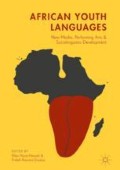Abstract
There is no doubt that youth in a number of urban centres in the African continent are continuously creating their own language in order to set themselves apart from the older generation. In Kenya, for instance, the youth use slang which may take the form of mixed codes to create social networks. Whereas the Kenyan curriculum has no room for the mixed codes, it is interesting to note how they have permeated Kenyan institutions and media; one such area is advertising. The advertising phenomenon is a household thing; it has become part and parcel of our present-day life. Every day we are bombarded with advertisements of different types, which intrude on our privacy through print, television and radio. Numerous campaigns are developed with the purpose of positioning products with an edge over others. The attractive power of advertisements is able to manipulate the consumer by advocating, encouraging, asking, announcing, persuading and finally becoming embedded in people’s minds. Of concern to a linguist is the linguistic input that goes into these advertisements. The fact that language has a powerful influence over people and their behaviour should not be underestimated. This is particularly true since the choice of language in advertising is made with the aim of influencing people. Traditionally, the English language has dominated advertising in Kenya because of its rich, extensive vocabulary. Where many other languages have only one or two words which carry a particular meaning, English may have five or six. This notwithstanding, the advertising scene has seen changes. In Kenya, for instance, with the emergence of Sheng the advertising industry has embraced it in a bid to target a particular audience. That is why this chapter examines the use of mixed codes in print, radio and television advertisements, focusing specifically on how they are used and bringing to the fore the different linguistic strategies employed in the advertisements.
References
Bolinger, D. (1980). Language: The loaded weapon. London: Longman.
Bucholtz, M. (2000). Language and youth culture. American Speech, 75, 280–283.
Collins English Dictionary. (2012).
Githiora, C. (2002). Sheng: Peer language, Swahili dialect or emerging creole? Journal of African Cultural Studies, 15(2), 159–181.
Haarmann, H. (1989). Symbolic values of foreign language use. Berlin: Mouton de Gruyter.
Kannan, R., & Tyagi, S. (2013). Use of language in advertisements. English for Specific Purposes, 13(37), 1–10.
Kariuki, A., Kanana, F. E., & Kebeya, H. (2015). The growth and use of Sheng in advertisement in selected businesses in Kenya. Journal of African Cultural Studies, 27(2), 22–26.
Lapsanska, J. (2006). The language of advertising with concentration on the linguistic means and the analysis of advertising slogans. Diploma thesis, Comenius University.
Lee, S. J. (2006). Linguistic construction of modernity: English mixing in Korean television commercials. Language in Society, 35, 59–61.
Leech, G. (1966). English in advertising. London: Longman.
Mazrui, A. M. (1995). Slang and code-switching: The case of Sheng in Kenya. Afrikanistische, Arbeitspapier, 42, 168–179.
McLaughlin, F. (Ed.). (2009). The languages of urban Africa. London: Continuum International Publishing Group.
Mutonya, M. (2008). Swahili advertising in Nairobi: Innovation and language shift. Journal of African Cultural Studies, 20, 3–14.
Mwazemba, J. (2006, October 8). The futility of fighting Sheng. East African Standard. http://www.mail-archive.com/africanlanguages@yahoogroups.com/msg00391.html (12/4/2017).
Osinde, K. (1986). An investigation into the social and structural aspects of an evolving language. MA thesis, University of Nairobi, Kenya.
Piller, I. (2001). Identity construction in multilingual advertising. Language in Society, 30, 153–186.
Author information
Authors and Affiliations
Editor information
Editors and Affiliations
Rights and permissions
Copyright information
© 2018 The Author(s)
About this chapter
Cite this chapter
Mose, E.G., Ombati, O.B. (2018). Creative Use of Urban Youth Language in Advertisements: A Case of Mixing Codes. In: Hurst-Harosh, E., Kanana Erastus, F. (eds) African Youth Languages . Palgrave Macmillan, Cham. https://doi.org/10.1007/978-3-319-64562-9_7
Download citation
DOI: https://doi.org/10.1007/978-3-319-64562-9_7
Published:
Publisher Name: Palgrave Macmillan, Cham
Print ISBN: 978-3-319-64561-2
Online ISBN: 978-3-319-64562-9
eBook Packages: Social SciencesSocial Sciences (R0)

